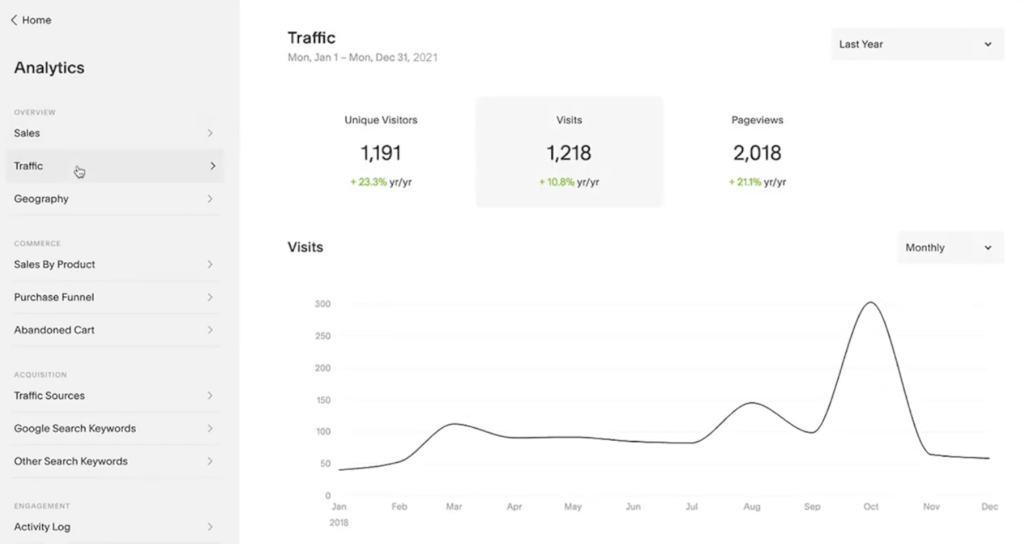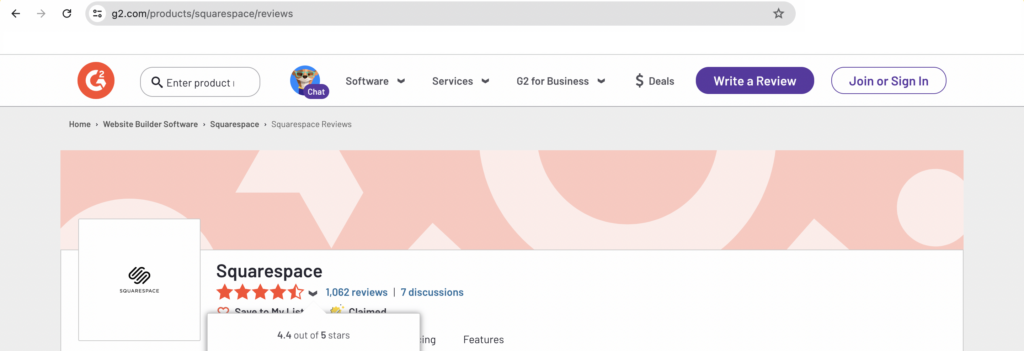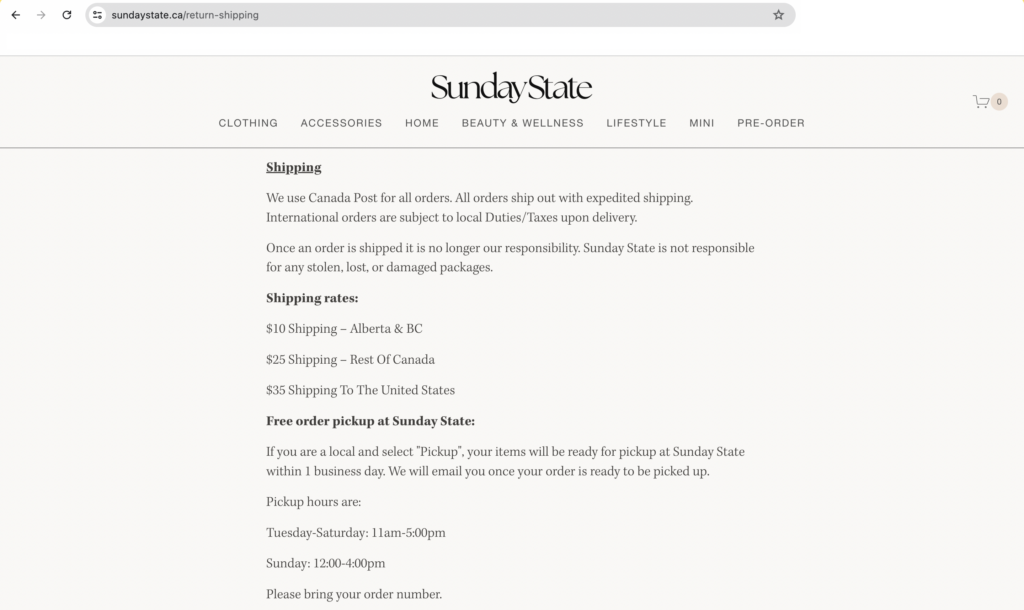The e-commerce landscape has grown exponentially in recent years, reaching 8.8 trillion dollars as of 2024. As many businesses join the competitive landscape, this market size continues to grow steadily.
While many strive for a large slice of the online shopping pie, to stand out in a crowded marketplace requires more than great products. Considering that a well-designed online store is your digital storefront, getting it right is vital to converting browsers into loyal customers.
That’s where Squarespace comes in. This powerful platform has become a game-changer for businesses seeking a user-friendly and visually stunning way to build and manage their online presence. Squarespace empowers entrepreneurs and creatives to showcase their products effectively, streamline the shopping experience, and ultimately drive sales.
Considering its potential, understanding how to use the platform properly can help accelerate and increase Squarespace store conversions. This guide will explore the platform’s importance and comprehensively elaborate on best practices in every key online storefront category.
A Quick Recap on Squarespace
Squarespace is likely a name you’ve encountered, even if you are new to e-commerce. Now, let’s have a quick overview of the platform and its advantages.
Squarespace is an all-in-one website-building and hosting platform specifically designed for entrepreneurs and small businesses. Its user-friendly interface and drag-and-drop functionality eliminate the need for coding knowledge, allowing anyone to create a professional and visually appealing online store.
The platform goes beyond aesthetics and offers a comprehensive suite of features tailored for e-commerce success. From managing product listings and inventory to secure payment processing and built-in marketing tools, Squarespace empowers you to manage your entire online store seamlessly.
Here are just a few of the key advantages that highlight how Squarespace is one of the best choices for businesses seeking to build a thriving online store:
- Ease of Use: Squarespace’s intuitive interface allows anyone, regardless of technical expertise, to create and manage a beautiful online store.
- Beautiful Templates: Choose from various pre-designed, mobile-responsive templates that cater to various industries and aesthetics.
- E-commerce Features: Squarespace offers robust e-commerce functionalities, including product management, inventory control, secure payment processing, and built-in marketing tools.
- Scalability: Squarespace plans can grow with your business, allowing you to add features and functionality as your online store expands.
Now, let’s delve into the best practices you can implement to increase Squarespace store conversions.
Best Practices to Accelerate Your Squarespace Store Conversions
While the advantages are numerous, it is important to appeal to your customers, reflect your business values, and highlight your brand quality to make the most of this powerful platform. Here are some essential best practices categorized into five key categories that are sure to increase your Squarespace conversions.
1. Product Page Best Practices

Your online shop’s product page is your first impression on potential customers. Each product page must have high-quality visuals and compelling product descriptions to drive your viewer’s interest.
Here are key best practices to ensure high-quality visuals on your product page:
- Invest in Professional Photography
Blurry or pixelated photos immediately turn customers away. A key practice that ensures clear visuals is to invest in professional photographers who understand how to showcase your product’s best features and textures in high-resolution images.
Additionally, a clean background keeps the focus on the product itself, and creative composition, along with editing techniques, elevates its visual appeal to potential customers.
- Showcase Products in Use
Static images tend to isolate your product and reduce its relatability. Showcase your products being used in real-world scenarios to help customers envision how they’d integrate seamlessly into their own lives.
Consider creating short, captivating videos featuring product functionality or happy customers using your products to add an extra layer of engagement.
- Multiple Angles and Zoom Options
A single image often leaves customers with an incomplete mental impression. Provide multiple views from different angles to give customers a complete understanding of the product’s design, including the front, back, and sides.
To assist customers further, adding zoom functionality with high-resolution images allows them to examine close-up details like intricate stitching on a garment or the finer points of a mechanism. This level of detail empowers customers to virtually examine your product as thoroughly as they would in a physical store, fostering informed purchase decisions.
In addition to quality visuals, here are three key practices to deliver compelling product descriptions,
- Focus on Benefits, Not Just Features
Craft descriptions that tell a story about your product’s benefits. This transforms your product page from a simple feature statement into a clear visual of its real-world advantage for the customer. Highlight the “why” behind features to make your descriptions resonate with your audience.
For example, instead of a “water-resistant jacket,” paint a picture: “Our water-resistant jacket keeps you comfortable with advanced materials that repel rain, letting you focus on enjoying the moment even in heavy downpours.”
- Target Audience Language
Speak directly to your ideal customer. Research your target audience to understand their needs and desires, and then tailor your descriptions to address these specific needs. This highlights how your product provides the perfect solution.
Also, remember to use language that resonates with them. This will include considering age group-specific lingo and the level of your ideal customer’s expertise and knowledge.
- Use Storytelling and Emotional Connection
Emotions are a powerful driving force behind purchases. Your product descriptions must weave a story or evoke emotions to create a strong connection with potential customers.
This would entail describing the problem your product solves, the emotions it evokes (confidence, joy, relaxation), and the positive impact it has on their day-to-day experience.
2. Navigation and Checkout Process Best Practices
Another crucial element to increasing Squarespace store conversions is ensuring a seamless shopping experience. Your webpage must have robust site navigation and easy checkout.
Here are some site navigation practices to incorporate into your online shop:

- Clear and Simple Menus
An online shop’s menu allows customers access to the business’s products. Ensure your menus are clear, concise, and logically organized. Well-organized menus allow visitors to find what they need quickly and efficiently, keeping them engaged and moving them closer to a purchase.
That said, it is important to avoid cluttering menus with too many dropdown options or using overly technical jargon. Instead, use clear and descriptive labels that accurately reflect the content within each category.
- Utilize Breadcrumbs
Breadcrumbs are a website’s navigational element that appears as a text path at the top of a webpage. It indicates a visitor’s current location within your website’s hierarchy. For instance, a breadcrumb trail might display “Home > Clothing > T-Shirts.”
Breadcrumbs provide valuable context to visitors, allowing them to understand how they arrived at a specific page and easily navigate back to previous sections. This is key to improving user experience and reduces the chances of visitors getting lost within your website’s structure.
- Search Functionality Optimization
A robust search bar empowers visitors to find the products they want. Considering this, ensuring your search function is prominently displayed, ideally within the header or navigation bar, is vital to keeping them engaged and facilitating purchases.
A key tip to adopting this practice is that the search bar should be easy to locate and utilize. Furthermore, optimize your product listings with relevant keywords to ensure accurate search results. Consider autosuggestion features that display relevant products as visitors begin typing their search queries.
As for a frictionless checkout process, ensure that these practices are put into place:

- Streamline Checkout Steps
The checkout process should be as simple and streamlined as possible. The fewer steps required, the smoother the journey for potential customers. When adopting this practice, minimize the required fields and avoid asking for non-essential information during checkout.
A lengthy or complex checkout process can lead to cart abandonment. Provide clear instructions and progress indicators throughout checkout, keeping visitors informed and reducing anxiety.
- Guest Checkout Option
Not all visitors will want to create an account during their first purchase. Another important practice is to allow your customers the option of guest checkout. This removes a potential hurdle, encouraging visitors to complete their purchase without extra steps.
While offering guest checkout, you should also capture essential customer information like email addresses. This allows you to nurture leads, increase Squarespace store conversions, and boost customer retention rates.
- Mobile-Friendly Checkout
With the growing popularity of mobile shopping, mobile commerce is valued at $557 billion in 2023. This highlights the magnitude of a mobile-friendly checkout process as a hygiene practice.
Your checkout page should be responsive and adjust seamlessly to different screen sizes and devices. Test your checkout process on various mobile devices to identify and rectify any potential issues with functionality or layout.
A smooth mobile checkout experience caters to the growing mobile shopping demographic and prevents them from abandoning their carts due to technical difficulties.
3. Squarespace Features Best Practices
Your online e-commerce platform comes with several features. Squarespace itself is quite feature-rich. Making the most of these platform features is vital to facilitating the most conversions.
Here are some practices to use its features to increase Squarespace store conversions:
- Organize Products for Easy Browsing
Squarespace provides various tools to organize your products effectively. Utilize product categories and subcategories to group similar items together. This logical organization makes it easier for visitors to browse and find their desired products and ultimately helps increase Squarespace store conversions.
This practice also involves enabling product filtering options based on size, color, price, or other relevant attributes. Product organization allows visitors to refine their search results and quickly narrow down their product choices, just like using filters on a shopping app.
- Leverage Related Products
Squarespace also allows you to showcase related products on individual product pages. This feature is a powerful tool for upselling and cross-selling.
By recommending products that complement the one a visitor is viewing, you can increase the average order value and improve Squarespace sales.
- Create a Sense of Urgency
Another key business practice, especially on web pages where holding your potential customer’s attention is quite tricky, is to create a sense of urgency. This can be achieved through tools and approaches such as limited-time sales, countdown timers, or limited-edition product offerings.
These tactics can nudge visitors towards a purchase decision by highlighting the potential for missing out on a good deal. Examples such as “Limited Offer” or “Flash Sale” can create a sense of urgency and encourage a purchase before the offer expires. However, avoid relying solely on urgency tactics. Remember to ensure your products and overall brand value justify the purchase decision.
4. Decision Making Best Practices

To succeed in any e-commerce space, how you make decisions helps steer your business in the right direction. Here are two practices to implement for the most informed decisions:
- Track Key Metrics
Squarespace analytics provide valuable insights into your online store’s performance. This feature helps you track key metrics such as website traffic, conversion rates, bounce rates, and average order value, which leads to accurate decision-making. Monitor these metrics regularly to identify trends and areas for improvement.
- Analyze Customer Behavior
Understanding how your customers interact with your website is essential for conversion optimization. Squarespace analytics can provide insights into visitor behavior patterns, such as the pages they visit, the products they view, and their purchasing journey.
A key decision-making practice is to analyze this data to understand your customer’s decision-making process and identify potential roadblocks. Customer behavior data reveals what products customers are interested in and where they might drop off during checkout, allowing you to tailor your approach for better results.
5. Trust and Credibility Development Best Practices
The trust and credibility customers and viewers have in your brand are among the elements that drive your business revenue. You must strengthen your customer feedback and communication handling to achieve such faith and brand imaging.
Here are two customer feedback management practices that increase Squarespace store conversions:

- Encourage Customer Reviews
Customer reviews are one of the leading forms of social proof in the online shopping industry, significantly impacting buying decisions. Positive reviews build trust and credibility with potential customers, while negative reviews offer valuable insights into areas for improvement.
Your business must inculcate the practice of encouraging customers to leave reviews for your products by offering incentives like discounts or loyalty points or by making the review process effortless. A simple and streamlined review process increases the likelihood of customers leaving feedback.
Remember, it’s important not to force or pressure your customers into leaving reviews. This could lead to inaccurate data for your decisions and business strategies.
- Address Negative Reviews Proactively
With a diverse range of customers and their evolving needs, having a perfect record is quite the challenge for an e-commerce business. While negative reviews are inevitable, how you handle them has the power to increase Squarespace store conversions drastically.
It is vital to address these negative reviews head-on to demonstrate a commitment towards meeting your customer needs. Set a practice of acknowledging negative reviews promptly and professionally. Thank the customer for their feedback, express your willingness to address their concerns, and offer solutions or explanations to demonstrate that you value their business.
Along with gaining trust that your business works towards customer needs, incorporate the following two communication practices to strengthen brand image and transparency:

- Comprehensive Shipping and Returns Policy
A clear and concise shipping and returns policy is essential for building trust with potential customers. Outline your shipping costs, timelines, and any restrictions so that your customers are informed and can trust that your business values take care of their needs.
Communicate your return policy, including the timeframe, conditions for accepted returns, and any associated fees. A transparent and customer-friendly shipping and returns policy removes purchase anxieties and encourages visitors.
- Secure Payment Gateway
When making online purchases, customers prioritize security. Ensure your Squarespace store is equipped with a secure and reputable payment gateway. This assures customers that their financial information is protected throughout the checkout process.
Display trust seals from recognized security providers on your website to enhance customer confidence and encourage them to complete their purchases without worry. Payment security is a non-negotiable factor in building trust with online shoppers.
Other key communication practices to increase Squarespace store conversions are to share your business contact details and make routine announcements on your social media accounts and webpage newsletters.
Increase Squarespace Store Conversions with a Drive
Squarespace offers a powerful platform for your online store, but increasing Squarespace store conversions requires understanding and implementing industry best practices. This guide has equipped you with a roadmap to jumpstart your conversion rates. Now, all that’s left is to focus on creating high-quality content, a crucial element for success.
That said, creating compelling content can be resource-intensive. That’s where Predis.ai comes in.
Predis.ai offers a suite of tools, such as the e-commerce video maker, to help you craft stunning visuals and write scroll-stopping descriptions. The platform also features the e-commerce store social media tool to seamlessly connect your Squarespace store with your social media channels and effortlessly create posts, too.
With these features, your business can create an engaging customer experience that drives sales. Sign up to discover how to boost Squarespace conversions today!















